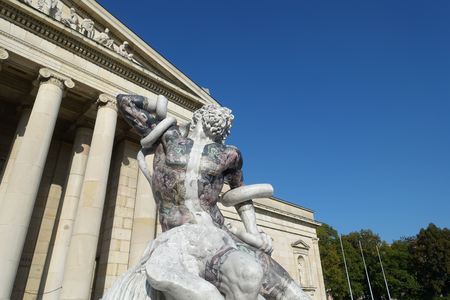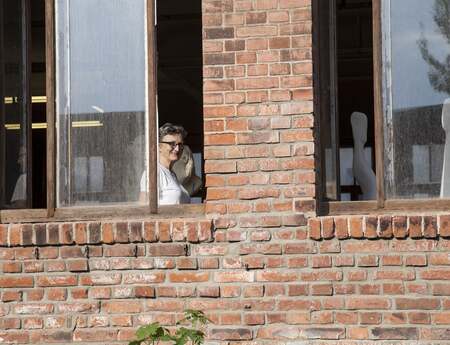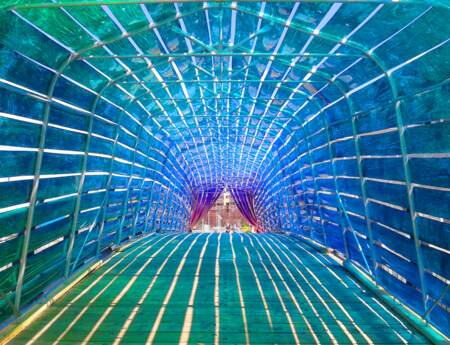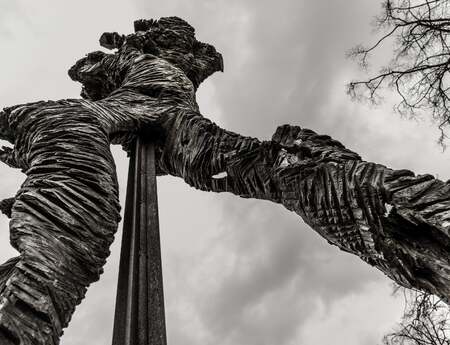In the footsteps of Ancient Times: a new interpretation of Marble
In the occasion of his exhibition "Sculptured in Stone - Sculptures by Fabio Viale” at the Glyptothek in Munich we met Fabio Viale, an Italian sculptor who is proudly working only marble. In this exclusive interview he told us about his working technic and his difficult beginning as artist.
Fabio Viale is proud to work daily with the material of sculpture par excellence: marble. The Italian sculptor is also a skilled communicator, able to entertain his audience for hours thanks to a rich repertoire of anecdotes, as he proved during our interview on the occasion of a guided tour through the exhibition "Sculptured in Stone - Sculptures by Fabio Viale". The exhibit opened on July 12th and is still on display until September 30th at the Glyptothek in Munich and has been very popular with critics and the public alike.
Viale learned to sculpt in Carrara, he knows the art world intimately, as well as the world of marble and can amaze people with his knowledge. His work, miraculously suspended between exaggerated hyper-technicism and radical performance, is a rare example of a successful compromise between technique and concept, form and substance, production and communication.
The Munich exhibition begins outside the Glytothek with the tattooed Laocoön and continues inside the various rooms. The public who arrives unprepared for the exhibition is stunned to discover that a wooden fruit box (La suprema, with which he won the prestigious Cairo Prize in 2015), a twisted inner tube (Orbitale), a large paper plane and a polystyrene Nike, are actually heavy marble sculptures. All of Viale's works are made of marble, he is not able to forsake this material because he is much too devoted to it to look for easier and cheaper possibilities.
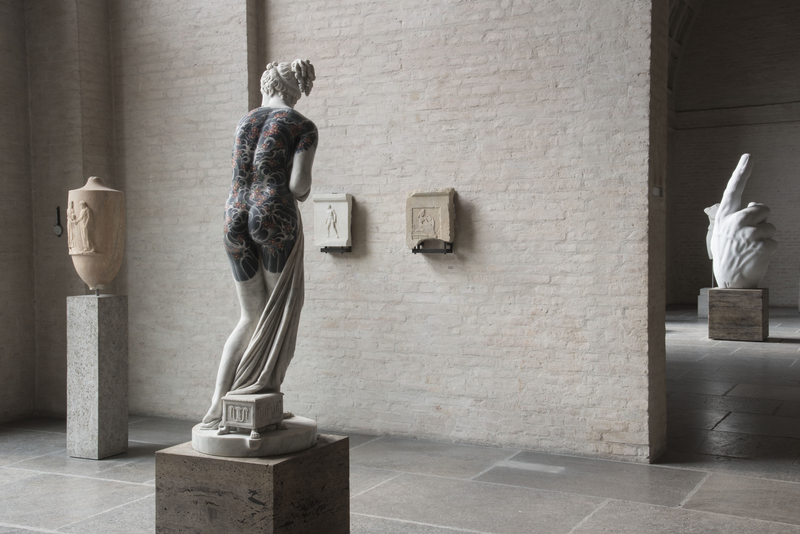
These sculptures are also conceptual devices necessary for the activation of dazzling performances. It is no coincidence that the first work to bring him fame was Aghalla; probably the first functional marble boat ever built in human history. Viale has actually sailed on several occasions since 2007 with Aghalla - an extremely risky undertaking. Another of his most powerful sculptures is a Pietá (Italian for pity) derived from Michelangelo in which you find an exhausted Nigerian Christian migrant of flesh and blood who has escaped from danger, discrimination, hunger and misery instead of the corpse of Jesus. The work was provocatively exhibited in Lampedusa, one of the most symbolic places of the Mediterranean coastal drama involving the trafficking of African immigrants and the smugglers who take advantage of their plight.
The Munich exhibition was set up in the rooms of the Glyptothek, where some of the greatest masterpieces of classical art are kept. Viale was very well aquainted with the faun Barberini and seeing the Hellenistic masterpiece in real life gave him inspiration for a new profane work. We talked about this during the interview and saw a preview but, for reasons of privacy and secrecy, we cannot say more until it is officially published.
The comparison between ancient and contemporary art is never easy: the sculptors and curators knew that even before embarking on this adventure, but the exhibition is objectively successful. Once the material substance of the works has been revealed, it is possible to recognize the continuity between the ancient and modern works and their function.
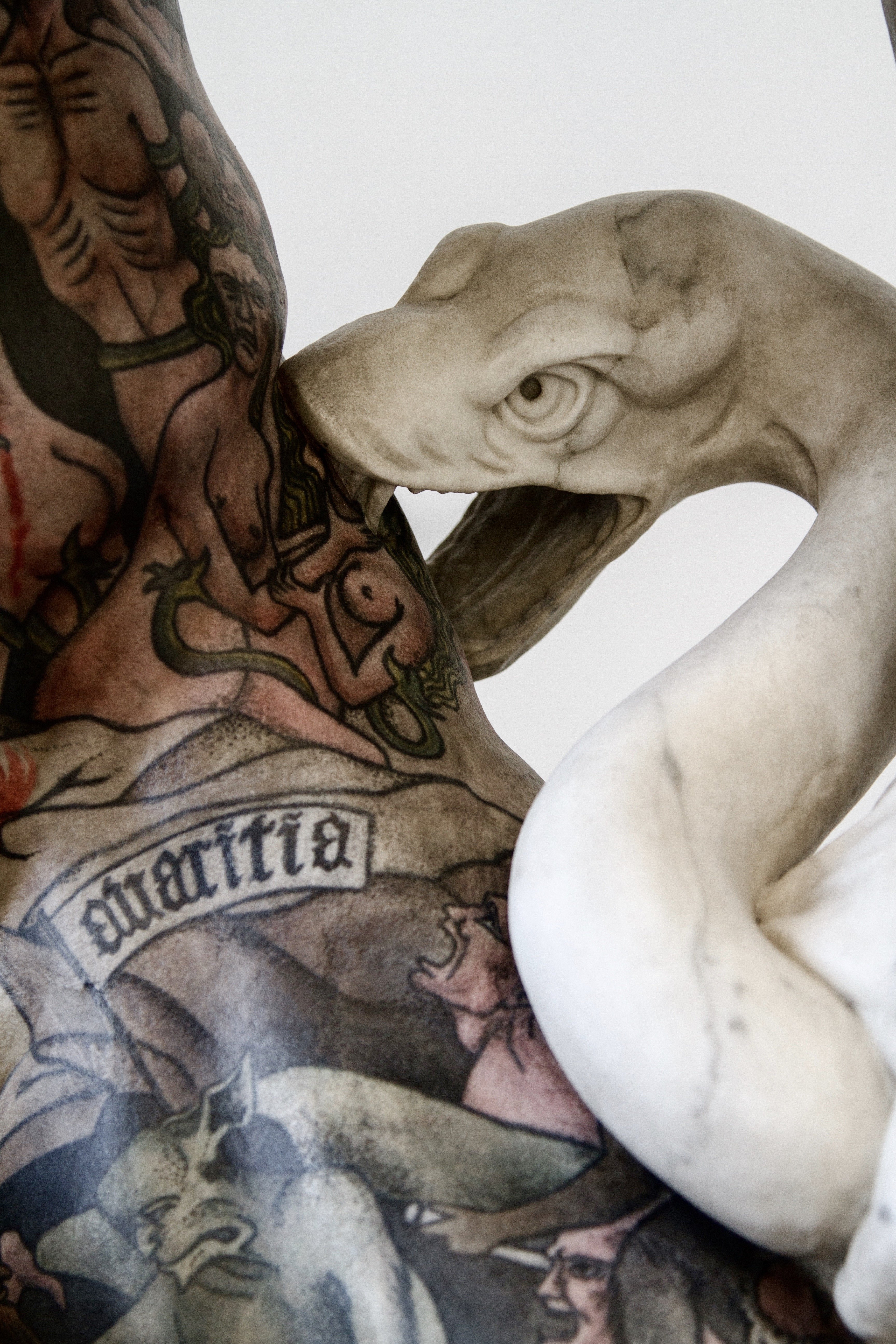
The popularity of Fabio Viale in the most common social networks leads us to consider some things: his images distributed via Instagram and Facebook speak clearly and directly to the public without the need for intermediaries. This could remind us of works that are too simple and popular, but a long conversation with the artist revealed an incredible conceptual depth, paired with multiple levels of reading.
The Viale case once again demonstrates that the present moment is good for contemporary sculpture. The market data, the initiatives developing, publications, exhibitions and the critical and commercial success of the sculptors are inescapable facts.
The interview with Viale is a good opportunity for us at sculpture network to dive into the world of Italian sculpture today. So we took advantage of the opportunity of this visit to the Bavarian capital to explore certain dynamics of the system together, as seen from the internal perspective of those who, suspended between dust and fatigue, make sculptures every day. The precious help of robots, and also of human helpers, which Fabio Viale also uses, make his works faster, but does not replace the daily work of the sculptor.
Thank you Fabio for taking time for us. I would like to begin this conversation by recalling some of your statements: to a journalist of the "Giornale" you said that "Michelangelo was thrown out of Carrara with stones: to resist, in the profession of a sculptor, you have to be a devil! Or: "Talent counts, but up to a certain point only the tough ones make it, those who have a knife between their teeth, who need to escape.” In 2015 you said to the Artribune: "I am a sculptor and not an artist".
You are a good communicator: you carve extremely heavy works that weigh tons, yet look like polystyrene, wood or rubber. You became famous by floating a marble boat, by rolling a tire of the same material and by substituting an immigrant in place of Christ. These are rapid and fresh intuitions that contrast with the slow execution that marble imposes. In times as fast as ours, your modus operandi is even more striking. Is this also the basis of the success that you currently enjoy in many environments?
One of the biggest problems of sculpture has always been time, which makes the difference between making the work in this life or the next. Today we still have to fight against the clock, but we have robots. A student can't afford one, and I got there gradually; they already existed ten years ago but today they are even competitive with artisans. Sculptors have always had help in the roughing phase; it does not diminish the art of the past to admit this. This is the most ignorant and tiring part, but working with marble includes various phases: first of all comes the choice of material. Each quarry has its own qualities and you need to look for the right one for the work you have in mind. Good materials are becoming increasingly rare because demand is global and Chinese buyers don’t leave much left over. Sculptors have to look for the quarryman’s friendship and be ruthless: Hirst recently paid 500,000 euros for a single block and the quarrymen are even proud of these type of deals. It's no coincidence that I started out thanks to the generosity of a quarryman from Carrara, whom I had gone to with an idea but without the money to make it happen. He looked at my hands, stared into my eyes and gave me the block of marble, a place to work and tools for free. He even invited me and my friends to dinner. Four years later this quarryman’s son saw one of my exhibitions, asked for the prices and then he was able to ask for 4,000 euros per ton (marble that cost 300). The Carrarini quarrymen’s problem comes from far away, they are very original people. Some of that is because in the old days prisoners and society’s worst were sent to Carrara. You had a hard job, it was difficult and you risked your life. Those who "deserved it" were sent there. Over the generations they created a certain manner and over the years they have consolidated their fame. Michelangelo himself escaped from Carrara, where the famous stones were thrown at him. From then on he preferred Pietrasanta over Carrara. Botero and Mitoraj also started in Carrara and then moved to Pietrasanta. I am from Piedmont but I love Carrara and if I had to buy a house I would take it there because it is a real city, without glamour, where there is the energy that allows you to start work. Having started sculpting there, it would be like returning home for me.
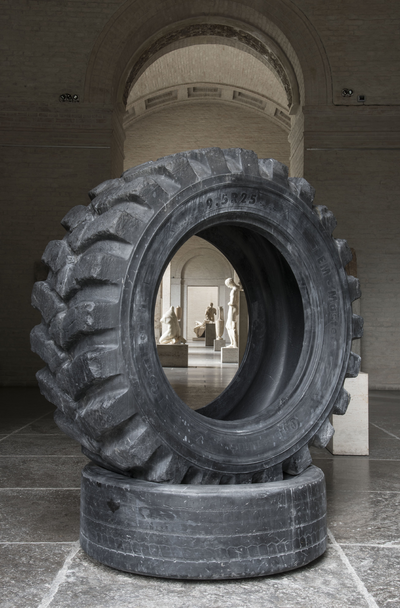
Let's move from Italy to Germany: What is your relationship with the German cultural world?
I came here by pure chance, because a designer who works in Pietrasanta had seen an exhibition at the Fortino Museum in Forte dei Marmi. He was organizing a fashion event and asked me if I would like to bring a work of mine to Munich. I didn't know the museum, but I was was familiar with the famous Barberini Faun in their collection, I talked to the management and we changed from one or two works to a full solo exhibition with a more structured catalogue. We established a trusting relationship and we considered the connection between the ancient and contemporary works, regardless of the material.
You earn your living from your sculptures: do you think that your fortune in a certain art market has made you freer and more independent compared to artists who live from public contracts?
If I couldn't sell the works I make then I would be a slave not only to the system, but also in my mind. Most artists who are able to enter certain environments and to realize certain exhibitions must also be able to please certain curators, who in turn have their own style and their own genre. They join a group hoping to emulate the success of those who are in that group, who live off it; if they didn’t have this need they would be freer. The beginning was hell: I bought my first car at the age of 31, my first summer holiday was that year as well. Before that I could only afford a bike and, in the summer, I had to work for marble workers, cemeteries and restorers in order to be able to finance new works that regularly went unsold. Then slowly the first pieces began to sell and I did less and less of the other jobs, but it was a slow and gradual process. Now that I can sell my works, I enjoy doing the kind of sculpture I prefer. There is one type of sculpture that is very annoying to a certain type of critic and that I, therefore, like to do even more. But that’s a project that we can't reveal at the moment and I don't know if I will ever be able to make it public. Maybe in the future.
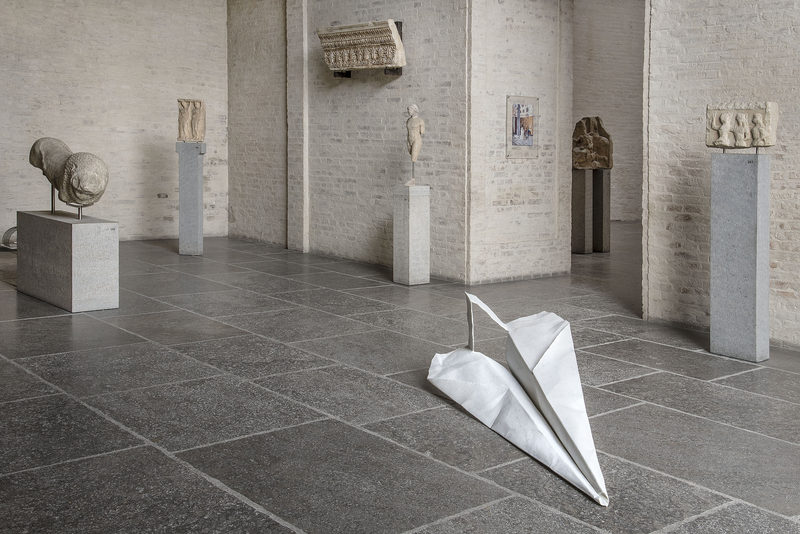
You are able to fill both the role of sculptor and the role of conceptual artist. How do you do it?
I can't answer that because, for me, marble is the key to everything. I couldn't think of making these pieces from any other material than marble. It's love and hate, I don't want to betray this ideal and I don't want to fight it. Plus, nowadays, thanks to robots, it’s also possible to do extraordinary things which were not possible before.
I use the robot as a chisel and I have to try to make the most of it - to take this tool to the limit. There are very few laboratories that can use it well, one is Corsellini in Carrara; it is the only one that doesn’t need a scan. We did the work previously mentioned which I may reveal in the future by stealing images from the Glypto library. I sent people to take five or six hundred photos and we made a 3D scan. This gives you 360 degrees of freedom of action, possibilities that had never existed before. We're just starting out and you shouldn't be afraid to follow this path, even if it's not easy.
sculpture network has asked me to analyse the world of Italian sculpture. That’s one reason I came to your exhibition. What would you recommend to a European passionate about contemporary sculpture who wants to discover our country?
I would recommend Pietrasanta: Outside of the beautiful old town I recommend the classic trip to the foundries and workshops. That would allow you not only to understand Italian sculpture, but sculpture from around the world. Great artists still come here. For example Cattelan; but anybody who makes large sculptures goes through Carrara. The local craftsmen are well known for how badly they treat great artists. With my own eyes I saw Anish Kapoor and his translator showing projects to craftsmen. They, in turn, asked the translator if the artist had the money to pay for the projects otherwise they wouldn’t even have given him a cost estimate. Actually, artists like and enjoy this kind of attitude because it tells them something.
I have heard good things about Pietrasanta and the Virtual Museum of Sculpture and Architecture called MUSA.
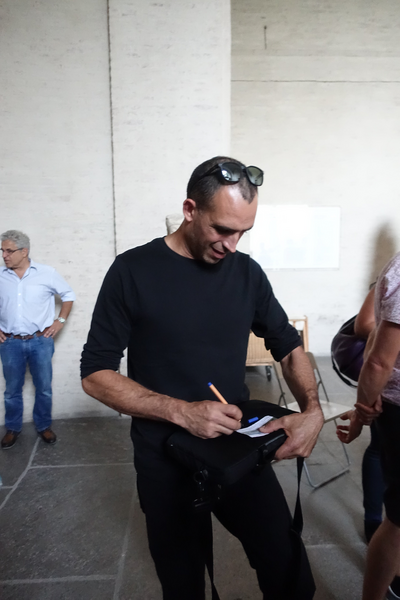
What is the situation at the gallery level?
I no longer work exclusively; I like to see galleries more as a point of sale,so that I have more freedom. Now I have the strength to produce my works and to give them to the gallery owners who I trust and who are accompanying me on my journey. At the Galleria Poggiali, which I collaborate with, there are two young men, the sons of the old Poggiali. They have spirit and try to suggest alternatives. I'm looking for galleries that tune in to these frequencies, but obviously abroad.
I think that social networks will change the rules and many artists will move toward independence, away from galleries. Today 70% of American collectors look on Instagram before buying a piece; maybe they even find you thanks to Instagram. We shouldn't think that this isn't changing the system. In the two months that I've been on Instagram I've acquired more than 25,000 followers and in a year I'll probably have more. The museums will take this into consideration; if they don't, they will be cut off. Most likely artists will start to open their own galleries where you can see their works, with a permanent exhibition all year round. I'm thinking about that, too, but maybe it's not for everyone. Ultimately, the sculptor has to know how to make a sculpture, but he also has to know how to do business,
Are there any artists that you think deserve to be followed on social media?
This question strikes a nerve and awakes the entrepreneur in me, so that I can't mention the competition, but in my opinion there are some very good artists. It's not true that there aren’t any good artists in Italy, the problem is that the critics have a unilateral vision. That's why the the art world isn’t changing or making progress. With more openness even young people would understand that there can be more than one path and that they will be appreciated. If you are a gallery and you want to make suggestions different from those you find at Artisstima and Miarte, then you simply won't attend Artissima and Miarte. There is no need to discuss this, as a gallery owner you can’t even consider investing in different artists. It happens in Italy, but also at ArtBasel, which is a measure in this context. You walk around the stands and you feel like you're always in the same gallery.
In your discipline is the public market with its commission system or the private collecting system more important?
The public has no money. Ninety per cent of the works you see are donations from artists and there is also a corrupt system. It's embarrassing, but that’s the current situation.
Ninety-nine per cent of my work is for private individuals. I made a statue of Cavour for the former Italian President Napolitano which is now on permanent display at the Quirinale.
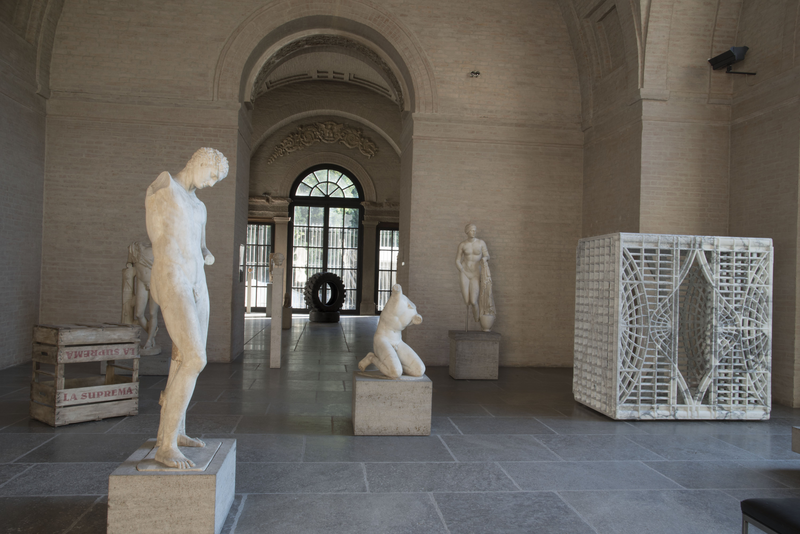
Now I would like to focus on your work: I read that you would delegate the work of sculpting to others if only you could find someone who is better than you are. That’s not a very convincing argument. To me it seems that these days, with 3D printing and numerically controlled machines an artist could find a number of tricks to get rid of the manual work. My feeling is that you are a militant sculptor. What do you think?
In short I would be an activist! But I'm creating clones: my way of using the material is causing many others to work in a similar manner. I taught at the academy for 3 years and did some damage: there are students who are doing things very similar to what I do and nowadays they can make a living from it. That wasn’t possible in my day. Anyway, I'm glad that there are more sculptors, the more the better. It will be an incentive to increase originality.
If you want to see Viale's exhibition you have time until 30th september.
Link to the exhibition: https://www.antike-am-koenigsplatz.mwn.de/de/antike-meisterwerke/sonderausstellungen/in-stein-gemeisselt.html
Link to the personal website of the sculptor: http://www.fabioviale.it
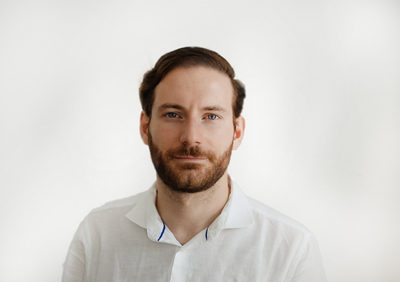
Author: Nicola Valentini
Italian art historian specialized in contemporary sculpture and new technologies recently joined our team in Munich for an internship.
